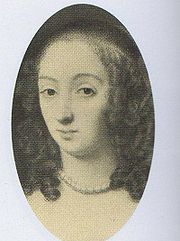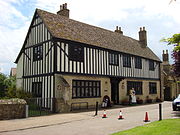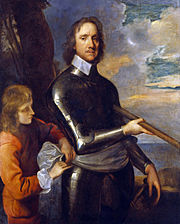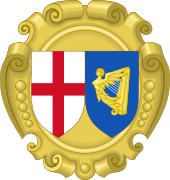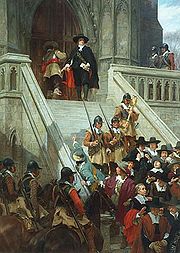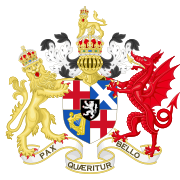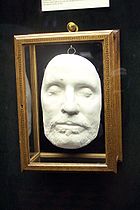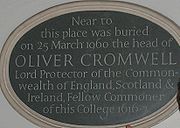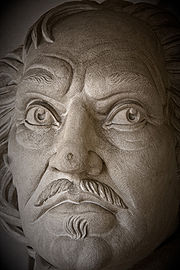
Oliver Cromwell
Background to the schools Wikipedia
This selection is made for schools by a children's charity read more. SOS Children has looked after children in Africa for forty years. Can you help their work in Africa?
| Oliver Cromwell | |
|---|---|
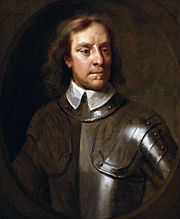 |
|
| Portrait of Oliver Cromwell by Samuel Cooper. | |
| 1st Lord Protector of the Commonwealth of England, Scotland and Ireland | |
| In office 16 December 1653 – 3 September 1658 (4 years, 261 days) |
|
| Preceded by | Council of State |
| Succeeded by | Richard Cromwell |
| Member of Parliament for Cambridge |
|
| In office 1640–1642 |
|
| Monarch | Charles I |
| In office 1640–1640 |
|
| Member of Parliament for Huntingdon |
|
| In office 1628–1629 |
|
| Personal details | |
| Born | 25 April 1599 Huntingdon, Cambridgeshire |
| Died | 3 September 1658 (aged 59) Whitehall, London |
| Resting place | Tyburn, London |
| Nationality | English |
| Spouse(s) | Elizabeth Bourchier |
| Relations | Robert Cromwell (father) Elizabeth Cromwell (mother) |
| Children | Robert Cromwell Oliver Cromwell Bridget Cromwell Richard Cromwell, Lord Protector Henry Cromwell, Lord Deputy of Ireland Elizabeth Cromwell Mary Cromwell Frances Cromwell |
| Alma mater | Sidney Sussex College, Cambridge |
| Occupation | Farmer; Parliamentarian; Military commander |
| Religion | Puritan ( Independent) |
| Signature | |
| Military service | |
| Nickname(s) | Old Ironsides |
| Allegiance | Roundhead |
| Service/branch | Eastern Association (1643–1645); New Model Army (1645–1646) |
| Years of service | 1643–51 |
| Rank | Colonel (1643 – bef. 1644); Lieutenant-General of Horse (bef. 1644–45); Lieutenant-General of Cavalry (1645–46) |
| Commands | Cambridgeshire Ironsides (1643 – bef. 1644); Eastern Association (bef. 1644–45); New Model Army (1645–46) |
| Battles/wars | Gainsborough; Marston Moor; Newbury II; Naseby; Langport; Preston; Dunbar; Worcester |
Oliver Cromwell (25 April 1599 – 3 September 1658) was an English military and political leader best known in England for his overthrow of the monarchy and temporarily turning England into a republican Commonwealth and for his rule as Lord Protector of England, Scotland and Ireland. In Ireland his record is harshly criticized.
Cromwell was one of the commanders of the New Model Army which defeated the royalists in the English Civil War. After the execution of King Charles I in 1649, Cromwell dominated the short-lived Commonwealth of England, conquered Ireland and Scotland, and ruled as Lord Protector from 1653 until his death in 1658.
Cromwell was born into the ranks of the middle gentry, and remained relatively obscure for the first 40 years of his life. His lifestyle resembled that of a yeoman farmer until he received an inheritance from his uncle. After undergoing a religious conversion during the same decade, Cromwell made an independent style of puritanism an essential part of his life. As a ruler he executed an aggressive and effective foreign policy and did as much as any English leader to shape the future of the land he governed. But his Commonwealth collapsed after his death and the royal family was restored in 1660. An intensely religious man—a Puritan Moses—he fervently believed God was guiding his victories. He was never identified, however, with any one sect or position, and strongly favoured religious tolerance for all the various Protestant groups.
He was elected Member of Parliament for Cambridge in the Short (1640) and Long (1640–49) Parliaments. He entered the English Civil War on the side of the "Roundheads" or Parliamentarians and became a key military leader. Nicknamed "Old Ironsides", he was quickly promoted from leading a single cavalry troop to command of the entire army. In 1649 he was one of the signatories of Charles I's death warrant and was a member of the Rump Parliament (1649–1653), which selected him to take command of the English campaign in Ireland during 1649–50. He led a campaign against the Scottish army between 1650 and 1651. On 20 April 1653 he dismissed the Rump Parliament by force, setting up a short-lived nominated assembly known as the Barebones Parliament, before being made Lord Protector of England, Wales, Scotland and Ireland on 16 December 1653. He was buried in Westminster Abbey. After the Royalists returned to power, they had his corpse dug up, hung in chains, and beheaded.
Cromwell has been one of the most controversial figures in the history of the British Isles— considered a regicidal dictator by some historians such as David Hume and Christopher Hill; but as a hero of liberty by others such as Thomas Carlyle and Samuel Rawson Gardiner. In a 2002 BBC poll in Britain, Cromwell was elected as one of the Top 10 Britons of all time. His measures against Catholics in Scotland and Ireland have been characterised as genocidal or near-genocidal.
Early years
He was born at Cromwell House in Huntingdon on 25 April 1599, to Robert Cromwell and Elizabeth Steward. He was descended from Katherine Cromwell (born circa 1482), an older sister of Tudor statesman Thomas Cromwell. Katherine was married to Morgan ap William, son of William ap Yevan of Wales. The family line continued through Richard Williams, alias Cromwell, (c. 1500–1544), Henry Williams, alias Cromwell, (c. 1524–6 January 1604), then to Oliver's father Robert Cromwell (c. 1560–1617), who married Elizabeth Steward (c. 1564–1654) on the day of Oliver Cromwell's birth. Thomas thus was Oliver's great-great-great-uncle.
His father was a younger son of a family founded by Thomas Cromwell (c. 1485-1540), a minister of Henry VIII, which had acquired considerable wealth by taking over monastery property during the Reformation. At the time of Oliver's birth his grandfather, Sir Henry Williams, was one of the two wealthiest landowners in Huntingdonshire, but his father was of modest means but still inside the gentry class. As a younger son with many siblings, Robert's inheritance was limited to a house at Huntingdon and a small amount of land. This land would have generated an income of up to £300 a year, near the bottom of the range of gentry incomes. Cromwell himself in 1654 said "I was by birth a gentleman, living neither in considerable height, nor yet in obscurity".
Records survive of Cromwell's baptism on 29 April 1599 at St. John's Church, and his attendance at Huntingdon Grammar School. He went on to study at Sidney Sussex College, Cambridge, which was then a recently founded college with a strong puritan ethos. He left in June 1617 without taking a degree, immediately after the death of his father. Early biographers claim he then attended Lincoln's Inn, but there is no record of him in the Inn's archives. Fraser (1973) concludes he likely did train at one of the London Inns of Court during this time. His grandfather, father, and two of his uncles had attended Lincoln's Inn; Cromwell also sent his son Richard there in 1647.
Cromwell probably returned home to Huntingdon after his father's death, for his mother was widowed and his seven sisters were unmarried, and he, therefore, was needed at home to help his family.
Marriage and family
On 22 August 1620 at St Giles-without-Cripplegate, London, Cromwell married Elizabeth Bourchier (1598–1665). They had nine children:
- Robert (1621–1639), died while away at school.
- Oliver (1622–1644), died of typhoid fever while serving as a Parliamentarian officer.
- Bridget (1624–1681), married (1) Henry Ireton, (2) Charles Fleetwood.
- Richard (1626–1712), his father's successor as Lord Protector.
- Henry (1628–1674), later Lord Deputy of Ireland.
- Elizabeth (1629–1658), married John Claypole.
- James (b. & d. 1632), died in infancy.
- Mary (1637–1713), married Thomas Belasyse, 1st Earl Fauconberg.
- Frances (1638–1720), married (1) Robert Rich, 3rd Earl of Warwick, (2) Sir John Russell, 3rd Baronet.
Elizabeth's father, Sir James Bourchier, was a London leather merchant who owned extensive land in Essex and had strong connections with puritan gentry families there. The marriage brought Cromwell into contact with Oliver St John and with leading members of the London merchant community, and behind them the influence of the earls of Warwick and Holland. Membership in this influential network would prove crucial to Cromwell’s military and political career.
Crisis and recovery
At this stage, though, there is little evidence of Cromwell's own religion. His letter in 1626 to Henry Downhall, an Arminian minister, suggests that Cromwell had yet to be influenced by radical puritanism. However, there is evidence that Cromwell went through a period of personal crisis during the late 1620s and early 1630s. He sought treatment for valde melancolicus (depression) from London doctor Theodore de Mayerne in 1628. He was also caught up in a fight among the gentry of Huntingdon over a new charter for the town, as a result of which he was called before the Privy Council in 1630.
In 1631 Cromwell sold most of his properties in Huntingdon—probably as a result of the dispute—and moved to a farmstead in St Ives. This was a major step down in society compared to his previous position, and seems to have had a significant emotional and spiritual impact. A 1638 letter survives from Cromwell to his cousin, the wife of Oliver St John, and gives an account of his spiritual awakening. The letter outlines how, having been "the chief of sinners", Cromwell had been called to be among "the congregation of the firstborn". The language of this letter, which is saturated with biblical quotations and which represents Cromwell as having been saved from sin by God's mercy, places his faith firmly within the Independent beliefs that the Reformation had not gone far enough, that much of England was still living in sin, and that Catholic beliefs and practices needed to be fully removed from the church.
In 1636, Cromwell inherited control of various properties in Ely from his uncle on his mother's side, as well as that uncle's job as tithe collector for Ely Cathedral. As a result, his income is likely to have risen to around £300–400 per year; and, by the end of the 1630s, Cromwell had returned to the ranks of acknowledged gentry. He had become a committed puritan and had also established important family links to leading families in London and Essex.
Member of Parliament: 1628–29 and 1640–42
Cromwell became the Member of Parliament for Huntingdon in the Parliament of 1628–1629, as a client of the Montagus. He made little impression: records for the Parliament show only one speech (against the Arminian Bishop Richard Neile), which was poorly received. After dissolving this Parliament, Charles I ruled without a Parliament for the next eleven years. When Charles faced the Scottish rebellion known as the Bishops' Wars, shortage of funds forced him to call a Parliament again in 1640. Cromwell was returned to this Parliament as member for Cambridge, but it lasted for only three weeks and became known as the Short Parliament. Cromwell moved his family from Ely to London in 1640.
A second Parliament was called later the same year. This was to become known as the Long Parliament. Cromwell was again returned to this Parliament as member for Cambridge. As with the Parliament of 1628–29, it is likely that Cromwell owed his position to the patronage of others, which would explain the fact that in the first week of the Parliament he was in charge of presenting a petition for the release of John Lilburne, who had become a puritan martyr after being arrested for importing religious tracts from Holland. Otherwise it is unlikely that a relatively unknown member would have been given this task. For the first two years of the Long Parliament, Cromwell was linked to the godly group of aristocrats in the House of Lords and Members of the House of Commons with which he had already established familial and religious links in the 1630s, such as the Earls of Essex, Warwick and Bedford, Oliver St John, and Viscount Saye and Sele. At this stage, the group had an agenda of godly reformation: the executive checked by regular parliaments, and the moderate extension of liberty of conscience. Cromwell appears to have taken a role in some of this group's political manoeuvres. In May 1641, for example, it was Cromwell who put forward the second reading of the Annual Parliaments Bill, and who later took a role in drafting the Root and Branch Bill for the abolition of episcopacy.
Military commander: 1642–46
English Civil War begins
Failure to resolve the issues before the Long Parliament led to armed conflict between Parliament and Charles I in the autumn of 1642; this was the beginning of the English Civil War. Before joining Parliament's forces, Cromwell's only military experience was in the trained bands, the local county militia. Now 43 years old, he recruited a cavalry troop in Cambridgeshire after blocking a valuable shipment of silver plate from Cambridge colleges that was meant for the king. Cromwell and his troop then fought at the indecisive Battle of Edgehill on 23 October 1642. The troop was recruited to be a full regiment in the winter of 1642 and 1643, making up part of the Eastern Association under the Earl of Manchester. Cromwell gained experience and victories in a number of successful actions in East Anglia in 1643, notably at the Battle of Gainsborough on 28 July. After this he was made governor of Ely and made a colonel in the Eastern Association.
Marston Moor
By the time of the Battle of Marston Moor in July 1644, Cromwell had risen to the rank of Lieutenant General of horse in Manchester's army. The success of his cavalry in breaking the ranks of the Royalist cavalry and then attacking their infantry from the rear at Marston Moor was a major factor in the Parliamentarian victory. Cromwell fought at the head of his troops in the battle and was slightly wounded in the neck, stepping away briefly to receive treatment during the battle, but later returning to help force the victory. After Cromwell's nephew was killed at Marston Moor he wrote a famous letter to his brother-in-law. Marston Moor secured the north of England for the Parliamentarians, but failed to end Royalist resistance.
The indecisive outcome of the Second Battle of Newbury in October meant that by the end of 1644, the war still showed no signs of ending. Cromwell's experience at Newbury, where Manchester had let the King's army slip out of an encircling manoeuvre, led to a serious dispute with Manchester, whom he believed to be less than enthusiastic in his conduct of the war. Manchester later accused Cromwell of recruiting men of "low birth" as officers in the army, to which he replied: "If you choose godly honest men to be captains of horse, honest men will follow them... I would rather have a plain russet-coated captain who knows what he fights for and loves what he knows than that which you call a gentleman and is nothing else". At this time, Cromwell also fell into dispute with Major-General Lawrence Crawford, a Scottish Covenanter Presbyterian attached to Manchester's army, who objected to Cromwell's encouragement of unorthodox Independents and Anabaptists. Cromwell's differences with the Scots, at that time allies of the Parliament, would later develop into outright enmity in 1648 and in 1650–51.
New Model Army
Partly in response to the failure to capitalise on their victory at Marston Moor, Parliament passed the Self-Denying Ordinance in early 1645. This forced members of the House of Commons and the Lords, such as Manchester, to choose between civil office and military command. All of them—except for Cromwell, whose commission was given continued extensions and was allowed to remain in parliament—chose to renounce their military positions. The Ordinance also decreed that the army be "remodelled" on a national basis, replacing the old county associations; Cromwell contributed significantly to these military reforms. In April 1645 the New Model Army finally took to the field, with Sir Thomas Fairfax in command and Cromwell as Lieutenant-General of cavalry, and second-in-command. By this time, the Parliamentarians' field army outnumbered the King's by roughly two to one.
Battle of Naseby
At the critical Battle of Naseby in June 1645, the New Model smashed the King's major army. Cromwell led his wing with great success at Naseby, again routing the Royalist cavalry. At the Battle of Langport on 10 July, Cromwell participated in the defeat of the last sizeable Royalist field army. Naseby and Langport effectively ended the King's hopes of victory, and the subsequent Parliamentarian campaigns involved taking the remaining fortified Royalist positions in the west of England. In October 1645, Cromwell besieged and took the wealthy and formidable Catholic fortress Basing House, later to be accused of killing one hundred of its three-hundred-man Royalist garrison there after its surrender. Cromwell also took part in successful sieges at Bridgwater, Sherborne, Bristol, Devizes, and Winchester, then spent the first half of 1646 mopping up resistance in Devon and Cornwall. Charles I surrendered to the Scots on 5 May 1646, effectively ending the First English Civil War. Cromwell and Fairfax took the formal surrender of the Royalists at Oxford in June.
Cromwell's military style
Cromwell had no formal training in military tactics, and followed the common practice of ranging his cavalry in three ranks and pressing forward. This method relied on impact rather than firepower. His strengths were in an instinctive ability to lead and train his men, and in his moral authority. In a war fought mostly by amateurs, these strengths were significant and are likely to have contributed to the discipline of his cavalry.
Cromwell also introduced close-order cavalry formations, with troopers riding knee to knee; this was an innovation in England at the time, and was a major factor in his success. He kept his troops close together following skirmishes where they had gained superiority, rather than allowing them to chase opponents off the battlefield. This facilitated further engagements in short order, which allowed greater intensity and quick reaction to battle developments. This style of command was decisive at both Marston Moor and Naseby.
Politics: 1647–49
In February 1647 Cromwell suffered from an illness that kept him out of political life for over a month. By the time of his recovery, the Parliamentarians were split over the issue of the king. A majority in both Houses pushed for a settlement that would pay off the Scottish army, disband much of the New Model Army, and restore Charles I in return for a Presbyterian settlement of the Church. Cromwell rejected the Scottish model of Presbyterianism, which threatened to replace one authoritarian hierarchy with another. The New Model Army, radicalised by the failure of the Parliament to pay the wages it was owed, petitioned against these changes, but the Commons declared the petition unlawful. During May 1647, Cromwell was sent to the army's headquarters in Saffron Walden to negotiate with them, but failed to agree. In June 1647, a troop of cavalry under Cornet George Joyce seized the king from Parliament's imprisonment. Although Cromwell is known to have met with Joyce on 31 May, it is impossible to be sure what Cromwell's role in this event was.
Cromwell and Henry Ireton then drafted a manifesto—the " Heads of Proposals"—designed to check the powers of the executive, set up regularly elected parliaments, and restore a non-compulsory Episcopalian settlement. Many in the army, such as the Levellers led by John Lilburne, thought this was insufficient, demanding full political equality for all men, leading to tense debates in Putney during the autumn of 1647 between Fairfax, Cromwell and Ireton on the one hand, and radical Levellers like Colonel Rainsborough on the other. The Putney Debates ultimately broke up without reaching a resolution. The debates, and the escape of Charles I from Hampton Court on 12 November, are likely to have hardened Cromwell's resolve against the king.
Second Civil War
The failure to conclude a political agreement with the king eventually led to the outbreak of the Second English Civil War in 1648, when the King tried to regain power by force of arms. Cromwell first put down a Royalist uprising in south Wales led by Rowland Laugharne, winning back Chepstow Castle on 25 May and six days later forcing the surrender of Tenby. The castle at Carmarthen was destroyed by burning. The much stronger castle at Pembroke, however, fell only after a siege of eight weeks. Cromwell dealt leniently with the ex-royalist soldiers, less so with those who had previously been members of the parliamentary army, with John Poyer eventually being executed in London after the drawing of lots.
Cromwell then marched north to deal with a pro-Royalist Scottish army (the Engagers) who had invaded England. At Preston, Cromwell, in sole command for the first time with an army of 9,000, won a brilliant victory against an army twice that size.
During 1648, Cromwell's letters and speeches started to become heavily based on biblical imagery, many of them meditations on the meaning of particular passages. For example, after the battle of Preston, study of Psalms 17 and 105 led him to tell Parliament that "they that are implacable and will not leave troubling the land may be speedily destroyed out of the land". A letter to Oliver St John in September 1648 urged him to read Isaiah 8, in which the kingdom falls and only the godly survive. This letter suggests that it was Cromwell's faith, rather than a commitment to radical politics, coupled with Parliament's decision to engage in negotiations with the king at the Treaty of Newport, that convinced him that God had spoken against both the king and Parliament as lawful authorities. For Cromwell, the army was now God's chosen instrument. The episode shows Cromwell’s firm belief in " Providentialism"—that God was actively directing the affairs of the world, through the actions of "chosen people" (whom God had "provided" for such purposes). Cromwell believed, during the Civil Wars, that he was one of these people, and he interpreted victories as indications of God's approval of his actions, and defeats as signs that God was directing him in another direction.
King tried and executed

In December 1648, those MPs who wished to continue negotiations with the king were prevented from sitting for parliament by a troop of soldiers headed by Colonel Thomas Pride, an episode soon to be known as Pride's Purge. Thus gerrymandered, the remaining body of MPs, known as the Rump, agreed that Charles should be tried on a charge of treason. Cromwell was still in the north of England, dealing with Royalist resistance when these events took place. However, after he returned to London, on the day after Pride's Purge, he became a determined supporter of those pushing for the king's trial and execution. He believed that killing Charles was the only way to end the civil wars. The death warrant for Charles was eventually signed by 59 of the trying court's members, including Cromwell (who was the third to sign it); Fairfax conspicuously refused to sign. Charles was executed on 30 January 1649.
Establishment of the Commonwealth: 1649
After the execution of the King, a republic was declared, known as the Commonwealth of England. The Rump Parliament exercised both executive and legislative powers, with a smaller Council of State also having some executive functions. Cromwell remained a member of the Rump and was appointed a member of the Council. In the early months after the execution of Charles I, Cromwell tried but failed to unite the original group of 'Royal Independents' centred around St John and Saye and Sele, which had fractured during 1648. Cromwell had been connected to this group since before the outbreak of war in 1642 and had been closely associated with them during the 1640s. However, only St John was persuaded to retain his seat in Parliament. The Royalists, meanwhile, had regrouped in Ireland, having signed a treaty with the Irish Confederate Catholics. In March, Cromwell was chosen by the Rump to command a campaign against them. Preparations for an invasion of Ireland occupied Cromwell in the subsequent months. After quelling Leveller mutinies within the English army at Andover and Burford in May, Cromwell departed for Ireland from Bristol at the end of July.
Irish campaign: 1649–50
Cromwell led a Parliamentary invasion of Ireland from 1649–50. Parliament's key opposition was the military threat posed by the alliance of the Irish Confederate Catholics and English royalists (signed in 1649). The Confederate-Royalist alliance was judged to be the biggest single threat facing the Commonwealth. However, the political situation in Ireland in 1649 was extremely fractured: there were also separate forces of Irish Catholics who were opposed to the royalist alliance, and Protestant royalist forces that were gradually moving towards Parliament. Cromwell said in a speech to the army Council on 23 March that "I had rather be overthrown by a Cavalierish interest than a Scotch interest; I had rather be overthrown by a Scotch interest than an Irish interest and I think of all this is the most dangerous".
Cromwell's hostility to the Irish was religious as well as political. He was passionately opposed to the Roman Catholic Church, which he saw as denying the primacy of the Bible in favour of papal and clerical authority, and which he blamed for suspected tyranny and persecution of Protestants in Europe. Cromwell's association of Catholicism with persecution was deepened with the Irish Rebellion of 1641. This rebellion, although intended to be bloodless, was marked by massacres of English and Scottish Protestant settlers by Irish and Old English, and Highland Scot Catholics in Ireland. These settlers had settled on land seized from former, native Catholic owners to make way for the non-native Protestants. These factors contributed to the brutality of the Cromwell military campaign in Ireland.
Parliament had planned to re-conquer Ireland since 1641 and had already sent an invasion force there in 1647. Cromwell's invasion of 1649 was much larger and, with the civil war in England over, could be regularly reinforced and re-supplied. His nine month military campaign was brief and effective, though it did not end the war in Ireland. Before his invasion, Parliamentarian forces held only outposts in Dublin and Derry. When he departed Ireland, they occupied most of the eastern and northern parts of the country. After his landing at Dublin on 15 August 1649 (itself only recently defended from an Irish and English Royalist attack at the Battle of Rathmines), Cromwell took the fortified port towns of Drogheda and Wexford to secure logistical supply from England. At the Siege of Drogheda in September 1649, Cromwell's troops massacred nearly 3,500 people after the town's capture—comprising around 2,700 Royalist soldiers and all the men in the town carrying arms, including some civilians, prisoners, and Roman Catholic priests. Cromwell wrote afterwards that:
"I am persuaded that this is a righteous judgment of God upon these barbarous wretches, who have imbued their hands in so much innocent blood and that it will tend to prevent the effusion of blood for the future, which are satisfactory grounds for such actions, which otherwise cannot but work remorse and regret."
At the Siege of Wexford in October, another massacre took place under confused circumstances. While Cromwell was apparently trying to negotiate surrender terms, some of his soldiers broke into the town, massacred 2,000 Irish troops and up to 1,500 civilians, and burned much of the town. No disciplinary actions were taken against his forces subsequent to this second massacre.
After the taking of Drogheda, Cromwell sent a column north to Ulster to secure the north of the country and went on to besiege Waterford, Kilkenny and Clonmel in Ireland's south-east. Kilkenny surrendered on terms, as did many other towns like New Ross and Carlow, but Cromwell failed to take Waterford and at the siege of Clonmel in May 1650, he lost up to 2,000 men in abortive assaults before the town surrendered. One of his major victories in Ireland was diplomatic rather than military. With the help of Roger Boyle, 1st Earl of Orrery, Cromwell persuaded the Protestant Royalist troops in Cork to change sides and fight with the Parliament. At this point, word reached Cromwell that Charles II had landed in Scotland and been proclaimed king by the Covenanter regime. Cromwell therefore returned to England from Youghal on 26 May 1650 to counter this threat.
The Parliamentarian conquest of Ireland dragged on for almost three years after Cromwell's departure. The campaigns under Cromwell's successors Henry Ireton and Edmund Ludlow mostly consisted of long sieges of fortified cities and guerrilla warfare in the countryside. The last Catholic held town, Galway, surrendered in April 1652 and the last Irish troops capitulated in April of the following year.
In the wake of the Commonwealth's conquest, the public practice of Catholicism was banned and Catholic priests were murdered when captured. Kenyon, Ohlmeyer, p.314. All Catholic-owned land was confiscated in the Act for the Settlement of Ireland 1652 and given to Scottish and English settlers, the Parliament's financial creditors and Parliamentary soldiers. The remaining Catholic landowners were allocated poorer land in the province of Connacht—this led to the Cromwellian attributed phrase "To hell or to Connacht". Under the Commonwealth, Catholic landownership dropped from 60% of the total to just 8%.
Debate over Cromwell's effect on Ireland
The extent of Cromwell's brutality in Ireland has been strongly debated. Some historians argue that Cromwell never accepted that he was responsible for the killing of civilians in Ireland, claiming that he had acted harshly, but only against those "in arms". Other historians, however, cite Cromwell's contemporary reports to London including that of 27 September 1649 in which he lists the slaying of 3,000 military personnel, followed by the phrase "and many inhabitants". In September 1649, he justified his sack of Drogheda as revenge for the massacres of Protestant settlers in Ulster in 1641, calling the massacre "the righteous judgement of God on these barbarous wretches, who have imbued their hands with so much innocent blood." However, Drogheda had never been held by the rebels in 1641—many of its garrison were in fact English royalists. On the other hand, the worst atrocities committed in Ireland, such as mass evictions, killings and deportation of over 50,000 men, women and children as slaves to Bermuda and Barbados, were carried out under the command of other generals after Cromwell had left for England. On entering Ireland, Cromwell demanded that no supplies were to be seized from the civilian inhabitants, and that everything should be fairly purchased; "I do hereby warn....all Officers, Soldiers and others under my command not to do any wrong or violence toward Country People or any persons whatsoever, unless they be actually in arms or office with the enemy.....as they shall answer to the contrary at their utmost peril." Several English soldiers were hanged for disobeying these orders.
While the massacres at Drogheda and Wexford were in some ways typical of the day, especially in the context of the recently ended Thirty Years War which reduced the male population of Germany by up to half, there are few comparable incidents during Parliament's campaigns in England or Scotland. One possible comparison is Cromwell's Siege of Basing House in 1645—the seat of the prominent Catholic the Marquess of Winchester—which resulted in about 100 of the garrison of 400 being killed after being refused quarter. Contemporaries also reported civilian casualties, six Catholic priests and a woman. However, the scale of the deaths at Basing House was much smaller. Cromwell himself said of the slaughter at Drogheda in his first letter back to the Council of State: "I believe we put to the sword the whole number of the defendants. I do not think thirty of the whole number escaped with their lives." Cromwell's orders—"in the heat of the action, I forbade them to spare any that were in arms in the town"—followed a request for surrender at the start of the siege, which was refused. The military protocol of the day was that a town or garrison that rejected the chance to surrender was not entitled to quarter. The refusal of the garrison at Drogheda to do this, even after the walls had been breached, was to Cromwell justification for the massacre. Where Cromwell negotiated the surrender of fortified towns, as at Carlow, New Ross, and Clonmel, he respected the terms of surrender and protected the lives and property of the townspeople. At Wexford, Cromwell again began negotiations for surrender. However, the captain of Wexford castle surrendered during the middle of the negotiations, and in the confusion some of his troops began indiscriminate killing and looting. Amateur Irish historian (and Drogheda native) Tom Reilly has taken this argument further, claiming that the accepted versions of the campaigns in Drogheda and Wexford in which wholesale killings of civilians on Cromwell's orders took place "were a 19th century fiction". However, Reilly's conclusions have been rejected by other scholars.
Although Cromwell's time spent on campaign in Ireland was limited, and although he did not take on executive powers until 1653, he is often the central focus of wider debates about whether, as historians such as Mark Levene and John Morrill suggest, the Commonwealth conducted a deliberate programme of ethnic cleansing in Ireland. By the end of the Cromwellian campaign and settlement there had been extensive dispossession of landowners who were Catholic, and a huge drop in population.
The sieges of Drogheda and Wexford have been prominently mentioned in histories and literature up to the present day. James Joyce, for example, mentioned Drogheda in his novel Ulysses: "What about sanctimonious Cromwell and his ironsides that put the women and children of Drogheda to the sword with the bible text God is love pasted round the mouth of his cannon?" Similarly, Winston Churchill described the impact of Cromwell on Anglo-Irish relations:
...upon all of these Cromwell's record was a lasting bane. By an uncompleted process of terror, by an iniquitous land settlement, by the virtual proscription of the Catholic religion, by the bloody deeds already described, he cut new gulfs between the nations and the creeds. 'Hell or Connaught' were the terms he thrust upon the native inhabitants, and they for their part, across three hundred years, have used as their keenest expression of hatred 'The Curse of Cromwell on you.' ... Upon all of us there still lies 'the curse of Cromwell'."
Cromwell is still a figure of hatred in Ireland, his name being associated with massacre, religious persecution, and mass dispossession of the Catholic community there. As Churchill notes, a traditional Irish curse was mallacht Chromail ort or "the curse of Cromwell upon you".
The key surviving statement of Cromwell's own views on the conquest of Ireland is his Declaration of the lord lieutenant of Ireland for the undeceiving of deluded and seduced people of January 1650. In this he was scathing about Catholicism, saying that "I shall not, where I have the power... suffer the exercise of the Mass." However, he also declared that: "as for the people, what thoughts they have in the matter of religion in their own breasts I cannot reach; but I shall think it my duty, if they walk honestly and peaceably, not to cause them in the least to suffer for the same." Private soldiers who surrendered their arms "and shall live peaceably and honestly at their several homes, they shall be permitted so to do." As with many incidents in Cromwell's career, there is debate about the extent of his sincerity in making these public statements: the Rump Parliament's later Act of Settlement of 1652 set out a much harsher policy of execution and confiscation of property of anyone who had supported the uprisings.
Scottish campaign: 1650–51
Scots proclaim Charles as King
Cromwell left Ireland in May 1650 and several months later, invaded Scotland after the Scots had proclaimed Charles I's son Charles II as king. Cromwell was much less hostile to Scottish Presbyterians, some of whom had been his allies in the First English Civil War, than he was to Irish Catholics. He described the Scots as a people fearing His [God's] name, though deceived". He made a famous appeal to the General Assembly of the Church of Scotland, urging them to see the error of the royal alliance—"I beseech you, in the bowels of Christ, think it possible you may be mistaken." The Scots' reply was robust: "would you have us to be sceptics in our religion?" This decision to negotiate with Charles II led Cromwell to believe that war was necessary.
Battle of Dunbar
His appeal rejected, Cromwell's veteran troops went on to invade Scotland. At first, the campaign went badly, as Cromwell's men were short of supplies and held up at fortifications manned by Scottish troops under David Leslie. Cromwell was on the brink of evacuating his army by sea from Dunbar. However, on 3 September 1650, in an unexpected battle, Cromwell smashed the main army at the Battle of Dunbar, killing 4,000 Scottish soldiers, taking another 10,000 prisoner and then capturing the Scottish capital of Edinburgh. The victory was of such a magnitude that Cromwell called it, "A high act of the Lord's Providence to us [and] one of the most signal mercies God hath done for England and His people".
Battle of Worcester
The following year, Charles II and his Scottish allies made a desperate attempt to invade England and capture London while Cromwell was engaged in Scotland. Cromwell followed them south and caught them at Worcester on 3 September 1651. At the subsequent Battle of Worcester, Cromwell's forces destroyed the last major Scottish Royalist army. Charles II barely escaped capture, and subsequently fled to exile in France and the Netherlands, where he would remain until 1660. Many of the Scottish prisoners of war taken in the campaigns died of disease, and others were sent as indentured labours to the colonies. To fight the battle, Cromwell organised an envelopment followed by a multi pronged coordinated attack on Worcester which involved his forces attacking from three directions with two rivers partitioning his force. During the battle, Cromwell switched his reserves from one side of the river Severn to the other and back again. The editor of the Great Rebellion article of the Encyclopædia Britannica, eleventh edition noted that compared to the early Civil War Battle of Turnham Green, Worcester was a battle of manoeuvre, which the English parliamentary armies at the start of the war were unable to execute, and agreed with a German critic that it was a prototype for the Battle of Sedan (1870).
Scottish campaign concluded
In the final stages of the Scottish campaign, Cromwell's men, under George Monck, sacked the town of Dundee, killing up to 2,000 of its population of 12,000 and destroying the 60 ships in the city's harbour. During the Commonwealth, Scotland was ruled from England, and was kept under military occupation, with a line of fortifications sealing off the Highlands, which had provided manpower for Royalist armies in Scotland, from the rest of the country. The north west Highlands was the scene of another pro-royalist uprising in 1653–55, which was only put down with deployment of 6,000 English troops there. Presbyterianism was allowed to be practised as before, but the Kirk (the Scottish church) did not have the backing of the civil courts to impose its rulings, as it had previously.
Cromwell's conquest, unwelcome as it was, left no significant lasting legacy of bitterness in Scotland. The rule of the Commonwealth and Protectorate was, the Highlands aside, largely peaceful. Moreover, there was no wholesale confiscations of land or property. Three out of every four Justices of the Peace in Commonwealth Scotland were Scots and the country was governed jointly by the English military authorities and a Scottish Council of State. Although not often favourably regarded, Cromwell's name rarely meets the hatred in Scotland that it does in Ireland.
Return to England and dissolution of the Rump Parliament: 1651–53
From the middle of 1649 until 1651, Cromwell was away on campaign. In the meantime, with the king gone (and with him their common cause), the various factions in Parliament began to engage in infighting. On his return, Cromwell tried to galvanise the Rump into setting dates for new elections, uniting the three kingdoms under one polity, and to put in place a broad-brush, tolerant national church. However, the Rump vacillated in setting election dates, and although it put in place a basic liberty of conscience, it failed to produce an alternative for tithes or dismantle other aspects of the existing religious settlement. In frustration, in April 1653 Cromwell demanded that the Rump establish a caretaker government of 40 members (drawn both from the Rump and the army) and then abdicate. However, the Rump returned to debating its own bill for a new government. Cromwell was so angered by this that on 20 April 1653, supported by about forty musketeers, he cleared the chamber and dissolved the Parliament by force. Several accounts exist of this incident: in one, Cromwell is supposed to have said "you are no Parliament, I say you are no Parliament; I will put an end to your sitting". At least two accounts agree that Cromwell snatched up the mace, symbol of Parliament's power, and demanded that the "bauble" be taken away. Cromwell's troops were commanded by Charles Worsley, later one of his Major Generals and one of his most trusted advisors, to whom he entrusted the mace.
The establishment of Barebone's Parliament: 1653
After the dissolution of the Rump, power passed temporarily to a council that debated what form the constitution should take. They took up the suggestion of Major-General Thomas Harrison for a " sanhedrin" of saints. Although Cromwell did not subscribe to Harrison's apocalyptic, Fifth Monarchist beliefs—which saw a sanhedrin as the starting point for Christ's rule on earth—he was attracted by the idea of an assembly made up of men chosen for their religious credentials. In his speech at the opening of the assembly on 4 July 1653, Cromwell thanked God’s providence that he believed had brought England to this point and set out their divine mission: "truly God hath called you to this work by, I think, as wonderful providences as ever passed upon the sons of men in so short a time." Sometimes known as the Parliament of Saints or more commonly the Nominated Assembly, it was also called the Barebone's Parliament after one of its members, Praise-God Barbon. The assembly was tasked with finding a permanent constitutional and religious settlement (Cromwell was invited to be a member but declined). However, the revelation that a considerably larger segment of the membership than had been believed were the radical Fifth Monarchists led to its members voting to dissolve it on 12 December 1653, out of fear of what the radicals might do if they took control of the Assembly.
The Protectorate: 1653–58
| Royal styles of Oliver Cromwell Lord Protector of the Commonwealth |
|
|---|---|
 |
|
| Reference style | His Highness |
| Spoken style | Your Highness |
| Alternative style | Sir |
After the dissolution of the Barebones Parliament, John Lambert put forward a new constitution known as the Instrument of Government, closely modelled on the Heads of Proposals. It made Cromwell Lord Protector for life to undertake “the chief magistracy and the administration of government”. Cromwell was sworn in as Lord Protector on 16 December 1653, with a ceremony in which he wore plain black clothing, rather than any monarchical regalia. However, from this point on Cromwell signed his name 'Oliver P', standing for Oliver Protector—in a similar style to that used by English monarchs—and it soon became the norm for others to address him as "Your highness". As Protector, he had the power to call and dissolve parliaments but was obliged under the Instrument to seek the majority vote of a Council of State. Nevertheless, Cromwell's power was buttressed by his continuing popularity among the army. As the Lord Protector he was paid £100,000 a year.
Cromwell had two key objectives as Lord Protector. The first was "healing and settling" the nation after the chaos of the civil wars and the regicide, which meant establishing a stable form for the new government to take. Although Cromwell declared to the first Protectorate Parliament that, "Government by one man and a parliament is fundamental," in practice social priorities took precedence over forms of government. Such forms were, he said, "but ... dross and dung in comparison of Christ". The social priorities did not, despite the revolutionary nature of the government, include any meaningful attempt to reform the social order. Cromwell declared, "A nobleman, a gentleman, a yeoman; the distinction of these: that is a good interest of the nation, and a great one!", Small-scale reform such as that carried out on the judicial system were outweighed by attempts to restore order to English politics. Direct taxation was reduced slightly and peace was made with the Dutch, ending the First Anglo-Dutch War.
England's American colonies in this period consisted of the New England Confederation, the Providence Plantation, the Virginia Colony and the Maryland Colony. Cromwell soon secured the submission of these and largely left them to their own affairs, intervening only to curb his fellow Puritans who were usurping control over the Maryland Colony at the Battle of the Severn, by his confirming the former Catholic proprietorship and edict of tolerance there. Of all the English dominions, Virginia was the most resentful of Cromwell's rule, and Cavalier emigration there mushroomed during the Protectorate.
Cromwell famously stressed the quest to restore order in his speech to the first Protectorate parliament at its inaugural meeting on 3 September 1654. He declared that "healing and settling" were the "great end of your meeting". However, the Parliament was quickly dominated by those pushing for more radical, properly republican reforms. After some initial gestures approving appointments previously made by Cromwell, the Parliament began to work on a radical programme of constitutional reform. Rather than opposing Parliament’s bill, Cromwell dissolved them on 22 January 1655.
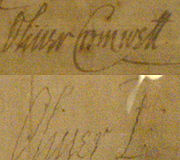
Cromwell's second objective was spiritual and moral reform. He aimed to restore liberty of conscience and promote both outward and inward godliness throughout England. During the early months of the Protectorate, a set of "triers" was established to assess the suitability of future parish ministers, and a related set of "ejectors" was set up to dismiss ministers and schoolmasters who were deemed unsuitable for office. The triers and the ejectors were intended to be at the vanguard of Cromwell's reform of parish worship. This second objective is also the context in which to see the constitutional experiment of the Major Generals that followed the dissolution of the first Protectorate Parliament. After a royalist uprising in March 1655, led by Sir John Penruddock, Cromwell (influenced by Lambert) divided England into military districts ruled by Army Major Generals who answered only to him. The 15 major generals and deputy major generals—called "godly governors"—were central not only to national security, but Cromwell's crusade to reform the nation's morals. The generals not only supervised militia forces and security commissions, but collected taxes and ensured support for the government in the English and Welsh provinces. Commissioners for securing the peace of the commonwealth were appointed to work with them in every county. While a few of these commissioners were career politicians, most were zealous puritans who welcomed the major-generals with open arms and embraced their work with enthusiasm. However, the major-generals lasted less than a year. Many feared they threatened their reform efforts and authority. Their position was further harmed by a tax proposal by Major General John Desborough to provide financial backing for their work, which the second Protectorate parliament—instated in September 1656—voted down for fear of a permanent military state. Ultimately, however, Cromwell's failure to support his men, sacrificing them to his opponents, caused their demise. Their activities between November 1655 and September 1656 had, however, reopened the wounds of the 1640s and deepened antipathies to the regime.
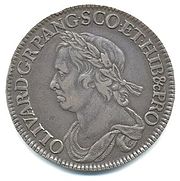
As Lord Protector, Cromwell was aware of the contribution the Jewish community made to the economic success of Holland, now England's leading commercial rival. It was this—allied to Cromwell's tolerance of the right to private worship of those who fell outside evangelical Puritanism—that led to his encouraging Jews to return to England in 1657, over 350 years after their banishment by Edward I, in the hope that they would help speed up the recovery of the country after the disruption of the Civil Wars.
In 1657, Cromwell was offered the crown by Parliament as part of a revised constitutional settlement, presenting him with a dilemma, since he had been "instrumental" in abolishing the monarchy. Cromwell agonised for six weeks over the offer. He was attracted by the prospect of stability it held out, but in a speech on 13 April 1657 he made clear that God's providence had spoken against the office of king: “I would not seek to set up that which Providence hath destroyed and laid in the dust, and I would not build Jericho again”. The reference to Jericho harks back to a previous occasion on which Cromwell had wrestled with his conscience when the news reached England of the defeat of an expedition against the Spanish-held island of Hispaniola in the West Indies in 1655—comparing himself to Achan, who had brought the Israelites defeat after bringing plunder back to camp after the capture of Jericho. Instead, Cromwell was ceremonially re-installed as Lord Protector on 26 June 1657 at Westminster Hall, sitting upon King Edward's Chair which was specially moved from Westminster Abbey for the occasion. The event in part echoed a coronation, utilising many of its symbols and regalia, such as a purple ermine-lined robe, a sword of justice and a sceptre (but not a crown or an orb). But, most notably, the office of Lord Protector was still not to become hereditary, though Cromwell was now able to nominate his own successor. Cromwell's new rights and powers were laid out in the Humble Petition and Advice, a legislative instrument which replaced the Instrument of Government. Despite failing to restore the Crown, this new constitution did set up many of the vestiges of the ancient constitution including a house of life peers (in place of the House of Lords). In the Humble Petition it was called the Other House as the Commons could not agree on a suitable name. Furthermore, Oliver Cromwell increasingly took on more of the trappings of monarchy. In particular, he created two baronages after the acceptance of the Humble Petition and Advice—Charles Howard was made Viscount Morpeth and Baron Gisland in July 1657 and Edmund Dunch was created Baron Burnell of East Wittenham in April 1658. Cromwell himself, however, was at pains to minimise his role, describing himself as a constable or watchman.
Death and posthumous execution
Cromwell is thought to have suffered from malaria and from " stone", a common term for urinary/kidney infections. In 1658 he was struck by a sudden bout of malarial fever, followed directly by illness symptomatic of a urinary or kidney complaint. A Venetian physician tracked Cromwell's final illness, saying Cromwell's personal physicians were mismanaging his health, leading to a rapid decline and death. The decline may also have been hastened by the death of his favourite daughter, Elizabeth Claypole, in August. He died aged 59 at Whitehall on Friday 3 September 1658, the anniversary of his great victories at Dunbar and Worcester. The most likely cause of Cromwell's death was septicaemia following his urinary infection. He was buried with great ceremony, with an elaborate funeral based on that of James I, at Westminster Abbey, his daughter Elizabeth also being buried there.
He was succeeded as Lord Protector by his son Richard. Although Richard was not entirely without ability, he had no power base in either Parliament or the Army, and was forced to resign in May 1659, ending the Protectorate. There was no clear leadership from the various factions that jostled for power during the short lived reinstated Commonwealth, so George Monck, the English governor of Scotland, at the head of New Model Army regiments was able to march on London, and restore the Long Parliament. Under Monck's watchful eye the necessary constitutional adjustments were made so that in 1660 Charles II could be invited back from exile to be king under a restored monarchy.
On 30 January 1661, (symbolically the 12th anniversary of the execution of Charles I), Oliver Cromwell's body was exhumed from Westminster Abbey, and was subjected to the ritual of a posthumous execution, as were the remains of John Bradshaw and Henry Ireton. (The body of Cromwell's daughter was allowed to remain buried in the Abbey.) His body was hanged in chains at Tyburn. Finally, his disinterred body was thrown into a pit, while his severed head was displayed on a pole outside Westminster Hall until 1685.
Ironically the Cromwell vault was then used as a burial place for Charles II’s illegitimate descendants. Afterwards the head changed hands several times, including the sale in 1814 to a man named Josiah Henry Wilkinson, before eventually being buried in the grounds of Sidney Sussex College, Cambridge, in 1960.
Political reputation
During his lifetime, some tracts painted him as a hypocrite motivated by power—for example, The Machiavilian Cromwell and The Juglers Discovered, both part of an attack on Cromwell by the Levellers after 1647, present him as a Machiavellian figure. More positive contemporary assessments—for instance, John Spittlehouse in A Warning Piece Discharged—typically compared him to Moses, rescuing the English by taking them safely through the Red Sea of the civil wars. Several biographies were published soon after his death. An example is The Perfect Politician, which described how Cromwell "loved men more than books" and gave a nuanced assessment of him as an energetic campaigner for liberty of conscience brought down by pride and ambition. An equally nuanced but less positive assessment was published in 1667 by Edward Hyde, 1st Earl of Clarendon, in his History of the Rebellion and Civil Wars in England. Clarendon famously declared that Cromwell "will be looked upon by posterity as a brave bad man". He argued that Cromwell's rise to power had been helped not only by his great spirit and energy, but also by his ruthlessness. Clarendon was not one of Cromwell's confidantes, and his account was written after the Restoration of the monarchy.
During the early eighteenth century, Cromwell's image began to be adopted and reshaped by the Whigs, as part of a wider project to give their political objectives historical legitimacy. A version of Edmund Ludlow’s Memoirs, re-written by John Toland to excise the radical Puritanical elements and replace them with a Whiggish brand of republicanism, presented the Cromwellian Protectorate as a military tyranny. Through Ludlow, Toland portrayed Cromwell as a despot who crushed the beginnings of democratic rule in the 1640s.
During the early nineteenth century, Cromwell began to be adopted by Romantic artists and poets. Thomas Carlyle continued this reassessment of Cromwell in the 1840s by presenting him as a hero in the battle between good and evil and a model for restoring morality to an age that Carlyle believed to have been dominated by timidity, meaningless rhetoric, and moral compromise. Cromwell's actions, including his campaigns in Ireland and his dissolution of the Long Parliament, according to Carlyle, had to be appreciated and praised as a whole.
By the late 19th century, Carlyle's portrayal of Cromwell, stressing the centrality of puritan morality and earnestness, had become assimilated into Whig and Liberal historiography. The Oxford civil war historian Samuel Rawson Gardiner concluded that "the man—it is ever so with the noblest—was greater than his work". Gardiner stressed Cromwell’s dynamic and mercurial character, and his role in dismantling absolute monarchy, while underestimating Cromwell’s religious conviction. Cromwell’s foreign policy also provided an attractive forerunner of Victorian imperial expansion, with Gardiner stressing his “constancy of effort to make England great by land and sea”.
During the first half of the twentieth century, Cromwell's reputation was often influenced by the rise of fascism in Nazi Germany and in Italy. Wilbur Cortez Abbott, for example—a Harvard historian—devoted much of his career to compiling and editing a multi-volume collection of Cromwell's letters and speeches. In this work, which was published between 1937 and 1947, Abbott began to argue that Cromwell was a proto-fascist. However, subsequent historians such as John Morrill have criticised both Abbott's interpretation of Cromwell and his editorial approach. Ernest Barker similarly compared the Independents to the Nazis. Nevertheless, not all historical comparisons made at this time drew on contemporary military dictators.
Late twentieth century historians re-examined the nature of Cromwell's faith and of his authoritarian regime. Austin Woolrych explored the issue of "dictatorship" in depth, arguing that Cromwell was subject to two conflicting forces: his obligation to the army and his desire to achieve a lasting settlement by winning back the confidence of the political nation as a whole. Woolrych argued that the dictatorial elements of Cromwell's rule stemmed not so much from its military origins or the participation of army officers in civil government, as from his constant commitment to the interest of the people of God and his conviction that suppressing vice and encouraging virtue constituted the chief end of government.
Historians such as John Morrill, Blair Worden and J. C. Davis have developed this theme, revealing the extent to which Cromwell’s writing and speeches are suffused with biblical references, and arguing that his radical actions were driven by his zeal for godly reformation.
Monuments and posthumous honours

The noted 19th century engineer Sir Richard Tangye was a noted Cromwell enthusiast, and noted collector of Cromwell manuscripts and memorabilia. His collection included many rare manuscripts and printed books, medals, paintings, objets d'art and a bizarre assemblage of "relics." This includes Cromwell's bible, button, coffin plate, death mask and funeral escutcheon. On Tangye's death, the entire collection was donated to the Museum of London, where it can still be seen today.
- In 1776, one of the first ships commissioned to serve in the Continental Navy during the American Revolutionary War was christened the Oliver Cromwell.
- In Westminster Abbey the site of Cromwell’s burial was marked, during the 19th century, by a floor stone, laid in what is now the Air Force Chapel, reading THE BURIAL PLACE OF OLIVER CROMWELL 1658–1661.
- In 1851, the newly-incorporated town of Cromwell, Connecticut in the United States was named after him.
- In 1875, a statue of Cromwell by Matthew Noble was erected in Manchester outside the cathedral, a gift to the city by Mrs Abel Heywood in memory of her first husband. It was the first such large-scale statue to be erected in the open anywhere in England and was a realistic likeness, based on the painting by Peter Lely and showing Cromwell in battledress with drawn sword and leather body armour. The statue was unpopular with the local Conservatives and with the large Irish immigrant population alike. When Queen Victoria was invited to open the new Manchester Town Hall, she is alleged to have consented on condition that the statue of Cromwell be removed. The statue remained, Victoria declined, and the Town Hall was opened by the Lord Mayor. During the 1980s the statue was relocated outside Wythenshawe Hall, which had been occupied by Cromwell and his troops - image.
- During the 1890s plans to erect a statue of Cromwell outside Parliament caused considerable controversy. Pressure from the Irish Nationalist Party forced the withdrawal of a motion to seek public funding for the project and eventually it was funded privately by Lord Rosebery. In 2008 the statue was restored to mark the 350th anniversary of Cromwell’s death.
- There is an above life-sized statue of Cromwell in the centre of St Ives, Cambridgeshire where he blew up the bridge to prevent the royalist troops approaching London - image.
- A statue of Cromwell also stands outside The Academy in Bridge Street, Warrington, an historic building which is now home to the Warrington Guardian newspaper. Cromwell fought the battle of Warrington Bridge against Scottish Royalists in the town in 1648.
- As First Lord of the Admiralty before the First World War, Winston Churchill suggested naming a British battleship HMS Oliver Cromwell. The suggestion did not meet with royal approval.
- In 1940 “Cromwell” was the codeword warning that German invasion of Britain was imminent.
- A steam locomotive built by British Railways, 70013 Oliver Cromwell was named after Cromwell.
- The Cromwell Tank, a Britsh WWII cruiser tank was named after him.
In popular culture
- In one of the earliest novels to feature Cromwell as a character, Abbe Prevost's Le philosophe anglais (1731–39), he is portrayed as a hypocritical womaniser, a deceitful tyrant, and a coward. The protagonist of this novel, Mr Cleveland, is the illegitimate son of Cromwell via one of Charles I's cast-off mistresses. For a synopsis, go to: http://www.angelfire.com/il/ClevelandFamilyChron/Book.html
- Cromwell’s adoption by the French Romantic movement was typified by Victor Hugo's 1827 play Cromwell, often considered to be symbolic of the French romantic movement, which represents Cromwell as a ruthless yet dynamic Romantic hero. A similar impression of a world-changing individual with a strong will and personality was provided in 1831 in the picture by French artist Hippolyte Delaroche, depicting the legendary visit by Cromwell to the body of Charles I after the King’s execution.
- Rutland Boughton's Symphony No. 1 (1904-05) was subtitled "Oliver Cromwell".
- 1970 saw the release of the Ken Hughes film Cromwell starring Richard Harris in the leading role. To Kill a King, a film of 2003 focussed on the relationship between Dougray Scott as Fairfax and Tim Roth as Cromwell, with Rupert Everett as King Charles I. Jack Shepherd’s 2004 play Through a Cloud, set in 1656, imagines a meeting between Cromwell and John Milton.
- Oliver Cromwell was played by Bernard Hepton in the twelve-part radio series God's Revolution, which was written by Don Taylor, broadcast on BBC Radio 4 in 1998 and rebroadcast on BBC Radio 7 in 2010.
- Blackadder: The Cavalier Years features a parody of Cromwell played by Warren Clarke.
- Cromwell has also appeared in popular songs, such as:
- Elvis Costello’s 1979 hit pop single “ Oliver’s Army”
- “ Irish Blood, English Heart,” the 2004 single by Morrissey includes the lyrics: “I’ve been dreaming of a time when the English are sick to death of Labour and Tories / And spit upon the name Oliver Cromwell.”
- The Pogues mention him in their song “Young Ned of the Hill”: “A curse upon you Oliver Cromwell / You who raped our Motherland.”
- The 2004 song, “Tobacco Island,” by Irish-American punk band Flogging Molly
- A more light-hearted take on Cromwell’s life and deeds, “ Oliver Cromwell,” was released by Monty Python in 1989, in which a factually accurate capsule biography is sung to the music of Chopin's Polonaise in A-flat, Op. 53, for piano.
- Oliver Cromwell, played by Dominic West, is one of the main characters in the 2008 Channel 4 TV miniseries The Devil's Whore.
- Popular Australian fantasy author Kate Forsyth made Oliver Cromwell in her series The Chain of Charms.
- Protagonist “Alucard” of the Japanese manga, Hellsing, refers to his power restriction system as the Cromwell Invocation.
- In the The Adventures of Luther Arkwright, a comic book fantasy adventure spanning countless alternative universes, modern day England is a fascist theocracy ruled by a descendant of Cromwell.
- Orson Scott Card’s alternate historical fantasy novel series The Tales of Alvin Maker diverges from reality in that folk magic actually works, and because (unknown to him—he would’ve executed them for witchcraft had he known) at least one of his physicians had a healing “ knack,” Cromwell did not die so young, so the English Restoration never happened, causing drastic alterations in the 19th Century North American setting of the series (e.g. there were four separate nations in the area occupied by the real United States of the time, only one of which had that name). Cromwell himself does not appear in the series.
- “Cromwell Road” remains a popular street name in many British towns and cities, and towns in New Zealand and the United States have been named “Cromwell.”
- Neal Stephenson’s alternate historical novel series The Baroque Cycle contains many references to Cromwell, as well as extensive descriptions of his grass-roots supporters and their behaviour after The Restoration. This creates a detailed picture of the beliefs and attitudes of his supporters and the civil warriors after they have witnessed the destruction of all their dreams and accomplishments. The novel series begins in 1655, but Cromwell himself does not appear in the series.
- The Morganville Vampires Novels features Cromwell as a character. In the series, Cromwell is a vampire known as "Oliver"
